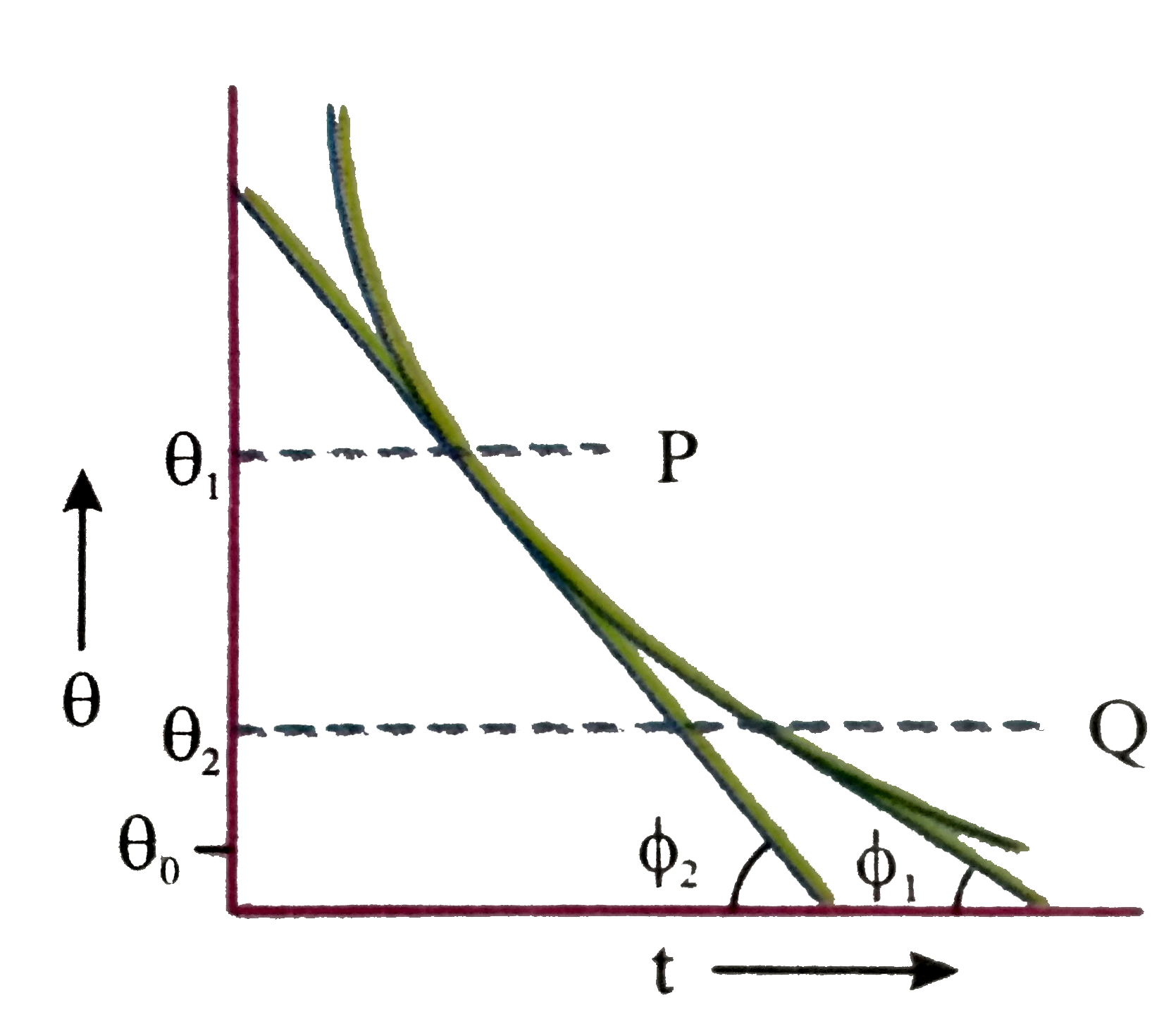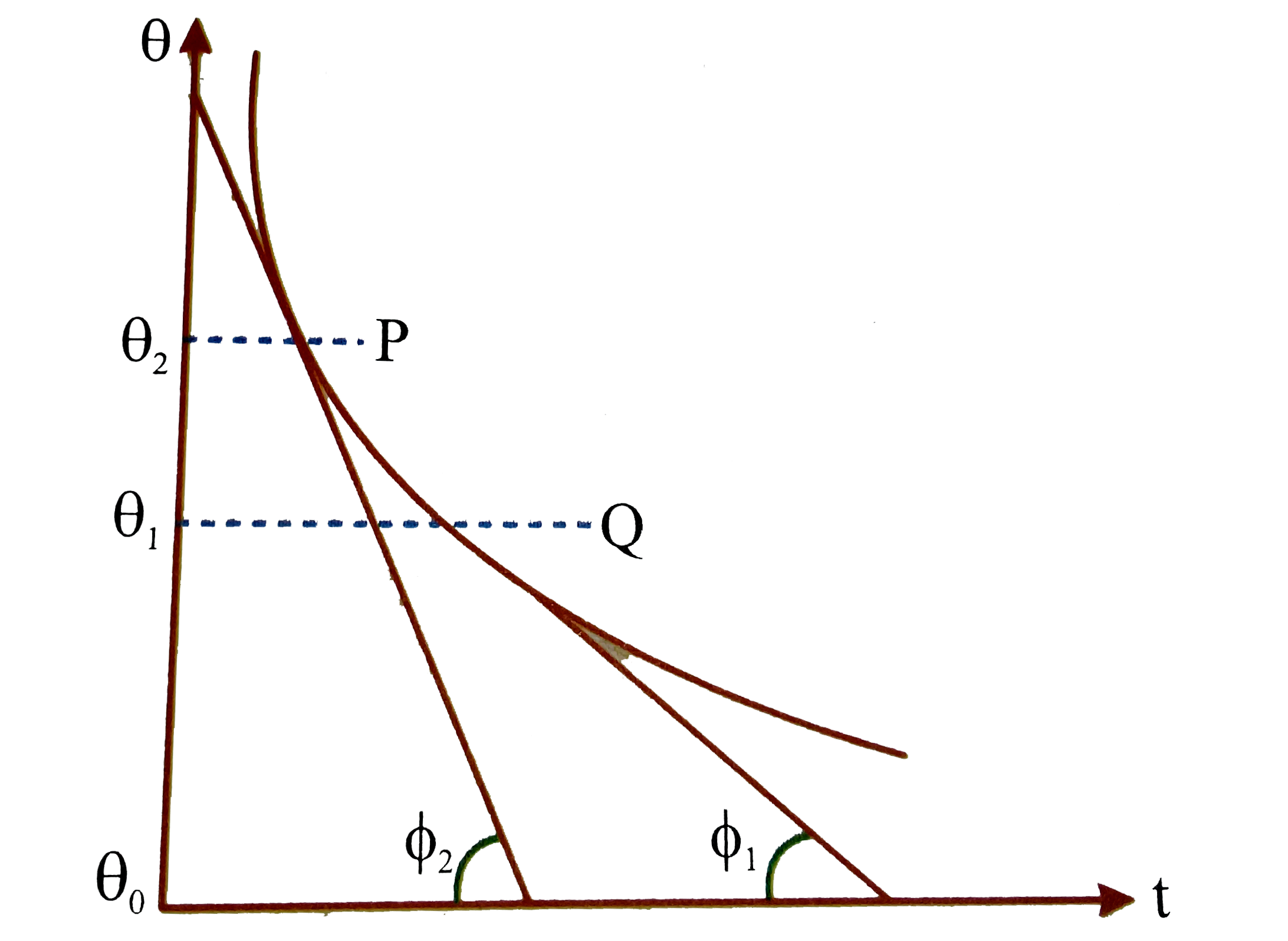A body cools in a surrounding which is at a constant temperature of θ0 Assume that it obeys Newton's law of cooling Its temperature θ is plotted against time t Tangents are drawn to the curve at the points P(θ=θ1) and Q(θ=θ2) These tangents meet the time axis at angle of ϕ2 andϕ1 as shown
 .
.
Video Solution
Text Solution
Temperature as a function of time is given as
T1−T0)e−kt
Slope of curve is
dTdt=−k(T1−T0)e−kt=−k(T−T0
if at T=T1 slope is tanθ1, we use
tanθ1=−k(T1−T0) …(1)
and at T=T2 slope is tanθ2, we use
tanθ2=−k(T2−T0) ...(2)
(2)(1) gives
tanθ2tanθ1=T2−T0T1−T0
|
Topper's Solved these Questions
- HEAT TRANSFER BOOK - PHYSICS GALAXY - ASHISH ARORACHAPTER - HEAT TRANSFER EXERCISE - Practice Exercise 4.4
5 Videos
- HEAT TRANSFER BOOK - PHYSICS GALAXY - ASHISH ARORACHAPTER - HEAT TRANSFER EXERCISE - Discussion Question
26 Videos
- HEAT TRANSFER BOOK - PHYSICS GALAXY - ASHISH ARORACHAPTER - HEAT TRANSFER EXERCISE - Practice Exercise 4.2
8 Videos
- HEAT AND THERMAL EXPANSIONBOOK - PHYSICS GALAXY - ASHISH ARORACHAPTER - HEAT AND THERMAL EXPANSIONEXERCISE - UNSOLVED NUMRICAL PROBLEMS FOR PREPARATION OF NSEP, INPhO & IPhO
82 Videos
- Kinetic Theory of Gases and Gas LawsBOOK - PHYSICS GALAXY - ASHISH ARORACHAPTER - Kinetic Theory of Gases and Gas LawsEXERCISE - Unsolved Numerical Problems for Preparation of NSEP, INPhO & IPhO
64 Videos
Similar Questions
Knowledge Check
A body cools in a surrounding which is at constant temperature of θ0. Assume that it obeys Newyon's law of colling. Its temperature θ is plotted against time t. Tangents are drawn to the curve at the points P(θ=θt) and Q(θ=θ2). These tangents meet the time axis at angles of ϕ2 and ϕ1, as shown
 Atanϕ2tanϕ1=θ1−θ0θ2−θ0Btanϕ2tanϕ1=θ2−θ0θ1−θ0Ctanϕ1tanϕ2=θ1θ2Dtanϕ1tanϕ2=θ2θ1
Atanϕ2tanϕ1=θ1−θ0θ2−θ0Btanϕ2tanϕ1=θ2−θ0θ1−θ0Ctanϕ1tanϕ2=θ1θ2Dtanϕ1tanϕ2=θ2θ1A body obeying Newton's law of cooling cools in a surrounding which is at a constant temperature Its temperature θ is plotted against time There are two points on the curve with temperatures θ2 and θ1(θ2>θ1) such that tangents on these points make angles of 2ϕ and half of its with time axis respectively Find the temperature of the surrounding .
Aθ1cos2ϕ−θ2(1+cos2ϕ)Bθ1(1+cos2ϕ)−θ2cos2ϕC(θ2−θ1)cos2ϕD2θ1+θ2(1+tan2ϕ)(1−tan2ϕ)A body with an initial temperature θ1 is allowed to cool in a surrounding which is at a constant temperature of θ0(θ<θ1) Assume that Newton's law of cooling is obeyed Let k= constant The temperature of the body after time t is best experssed by .
A(θi−θ0)e−ktB(θi−θ0)In(kt)Cθ0+(θi−θ0)e−ktDθie−kt−θ0
The equation of tangent to the curve x=a(θ+sinθ),y=a(1+cosθ) at θ=π2 is
View SolutionThe tangents to the curve x=a(θ−sinθ),y=a(1+cosθ) at the points θ=(2k+1)π,k∈Z are parallel to :
View SolutionTwo tangents are drawn from the point (−2,–1) to the parabola y2=4x. If θ is the angle between these tangents then tan θ =
View SolutionIn Newton's law of cooling experiment, we plot a graph of (dθdt) against the temperature difference (θ−θ0). The graph is
View SolutionIn Newton's law of cooling dθdt=−k(θ−θ0) the constant k is proportional to .
View Solution
